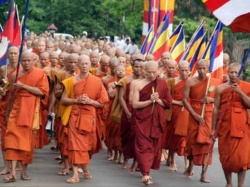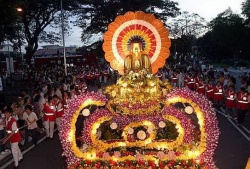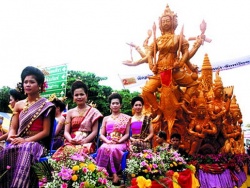A Calendar of Buddhist Observations
Visakha Puja (Vesak)— Three events in Lord Buddha’s life are believed to have occurred on the same day: birth, enlightment, and passing away. This is, therefore, one of the most important events in the Buddhist calendar. This celebration falls on the full moon of the sixth month of the lunar year (near the middle of May). This day’s events might include special lectures and sermons and, nowadays, special television shows. Candle processions (wian thian) around the main hall at many temples are also a prominent part of this observation.
Magha Puja — On this day, it is believed that a large group of enlightened monks spontaneously gathered to pay respect and hear the words of Lord Buddha. This event comes on the full moon of the third lunar month (February).
Asalha (Thai), Asalaha Puja — This event celebrates the preaching of a sermon to followers of Lord Buddha after they had attained enlightenment. The title of this sermon was Setting the Wheel of the Dhamma in Motion (Dhammacakkappavattana Sutta), and it is often referred to as the discourse on the Middle Way, the avoiding of extremes. This event is also taken to be the establishment of the religion and the third gem, the Sangha. It falls on the full moon of the eighth lunar month (July).
Khao Phansa (Entering the “Rainy Season Retreat”) — This is the beginning of so-called Buddhist Lent, a time when all ordinands must be associated with a particular temple and “stay put.” According to Thai tradition, this is the opportunity for young people to be ordained for at least a three-month period. During this time of retreat, ordinands seize the opportunity to spend a bit more quality time studying, writing, or meditating. In general, it is a more intensive time of focus. This is also a time for the emergence of young, budding rice plants; and one of the functions of this practice is to protect the new sprouts from any inadvertent wandering feet. This event falls on the first day after the full moon of the eighth lunar month (July).
It is a time of great merit-making and intense preparation for ordinands and their families. Building up to the time of the Rains Retreat laity often visit temples and make merit by assisting in the creation of large candles — ladling a portion of hot wax into a mold — that will be used by monks during this time of retreat. It is during this time that the Thet Mahachat (“Sermon of the Great Life” based on the Vessantara Jataka) is held in all-night recitations at certain temples.
Ok Phansa (Coming out of the “Rainy Season Retreat”) — This event signals the end of Buddhist Lent, and it is also a day of great joy and merit-making. At this time, those who have received temporary ordination are received back into the community. This event falls on the full moon of the eleventh lunar month (October).
Thot Kathin — At the time of the Buddha, this observance was a part of Buddhist practice and sustenance. As an exercise of self-reliance and humility, monks would cut, sew, and dye the cloth that would be used for their robes. (Some monks in the forest still dye their own cloth by cutting wood chips from the trunk of a Jackfruit tree, boiling them, and then stirring in the cloth to dye it an orange/yellow color.) The finished robes were then offered to the members of the monkhood who were worthy and needy. Currently, people tend to purchase manufactured robes, pre-packaged goods (including necessities like toiletries, towels, and so on), and then offer them to the temples. The events surrounding Kathin may involve intensive fund raising for various purposes, such as adding to or finishing a temple building. The time of Kathin can last up to a month from end of the Rains Retreat to the full moon of the twelfth lunar month (November).
Loi Krathong — “November full moonshine, Loi Krathong...and the water's high in the local river, Loi Krathong....” This festival is a fine example of how Buddhism blends with Brahman beliefs. In early November, to thank the water goddess and to ask for good fortune, people float (loi) banana leaves shaped like a lotus flower (krathong [nowadays many of these vessels are shaped of styrofoam and result in polluting waterways and jamming sewer drains]) at a local river, canal, or temple pond. The krathong usually contains incense, candles, and a few coins. The krathong floats away bad fortune and gives people hope for the coming new year.
Ngan (Pit Thong) Fang Luk Nimit — Driving through the countryside, you may see grand signs announcing this temple fair. These signs are often cleverly arranged in a series along the highway (like the old Burma Shave signs, for those of you who may remember them) announcing details of the event. The fair involves making merit by attaching gold leaf to a round stone that will eventually be buried as the heart-stone of the boundary stones (sima) of a new Ordination Hall (uposatha). Such fairs may go on for extended periods of time before the stone is actually buried.
Ngan Wat — Generic term for a temple fair that may suit various purposes.
Aside from these most prominent events, there are are many other colorful regional festivals that take place throughout the year.


